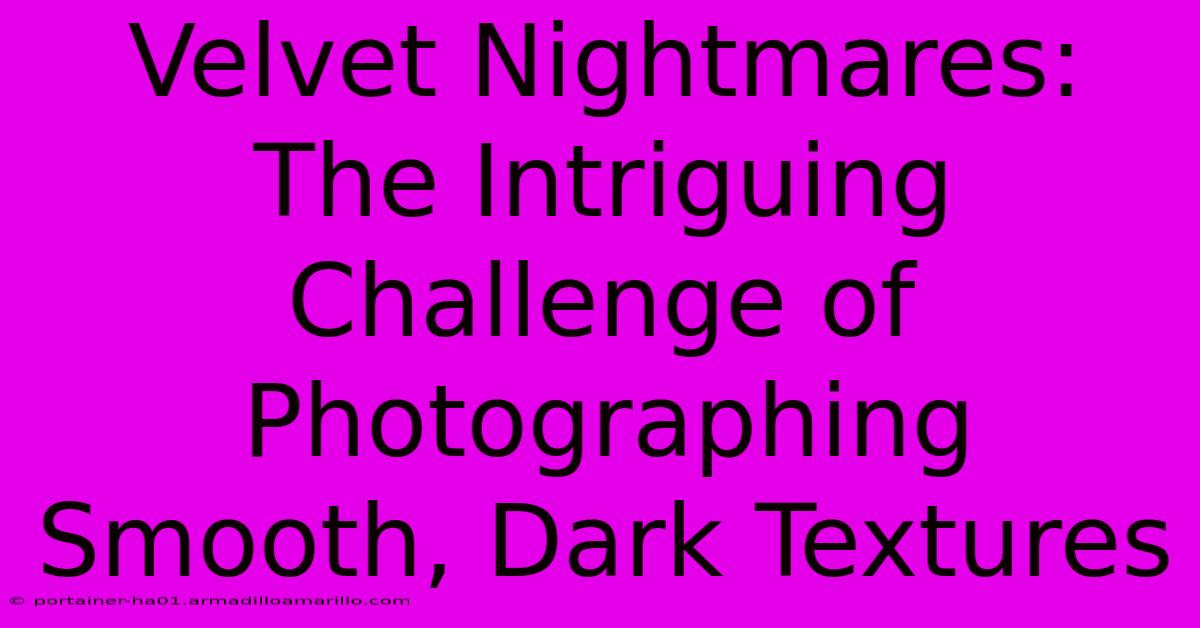Velvet Nightmares: The Intriguing Challenge Of Photographing Smooth, Dark Textures

Table of Contents
Velvet Nightmares: The Intriguing Challenge of Photographing Smooth, Dark Textures
Photographing smooth, dark textures like velvet can feel like a battle against the shadows. The very qualities that make these materials luxurious and alluring – their deep tones and subtle sheen – often present significant challenges to capturing their true beauty in a photograph. This article explores the intriguing difficulties inherent in photographing velvet and other similarly challenging materials, offering practical solutions to help you overcome these obstacles and achieve stunning results.
The Challenges of Dark, Smooth Surfaces
The primary hurdle in photographing dark, smooth textures lies in dynamic range. Cameras, while incredibly capable, struggle with scenes containing both extremely dark and bright areas simultaneously. Velvet, with its propensity to absorb light, often falls into deep shadow, losing detail and appearing as a flat, featureless black mass. This is exacerbated by the lack of texture; without discernible surface variations, the image loses its dimensionality and visual interest.
Specific Problems:
- Loss of Detail: The subtle variations in tone and texture that give velvet its rich character are easily lost in shadow.
- Flat Appearance: Without proper lighting and exposure, the velvet appears two-dimensional and lifeless.
- Unwanted Reflections: Smooth surfaces can reflect light sources, creating unwanted glare and distracting highlights.
- Camera Sensor Limitations: Digital sensors may struggle to accurately represent the subtleties of dark tones, leading to noise and banding.
Mastering the Art of Velvet Photography
Conquering these challenges requires a strategic approach to lighting, exposure, and post-processing.
Lighting Techniques for Velvet Success:
- Side Lighting: This is often the most effective technique. By illuminating the velvet from the side, you create subtle shadows that reveal the texture and give it depth. Experiment with the angle of your light source to find the most flattering effect.
- Backlighting: This can dramatically highlight the fibers and create a stunning silhouette effect, especially useful for showcasing the drape and flow of the fabric. Be mindful of exposure to avoid completely blowing out the highlights.
- Multiple Light Sources: Using several soft light sources – perhaps a combination of side and fill lighting – can provide more even illumination while still maintaining texture definition.
- Diffused Light: Avoid harsh, direct light which will create harsh shadows and glare. Use softboxes, diffusers, or shoot on an overcast day for softer, more even illumination.
Exposure and Camera Settings:
- Aperture Priority Mode (Av): This allows you to control depth of field while the camera automatically adjusts shutter speed. A narrower aperture (higher f-stop number) will provide greater depth of field, ensuring the entire subject is in focus.
- Manual Mode (M): For complete control, shoot in manual mode, carefully adjusting aperture, shutter speed, and ISO. You'll likely need to experiment to find the optimal settings for your specific lighting and scene.
- Expose to the Right (ETTR): Expose slightly brighter than what your camera's meter suggests. This helps preserve detail in the shadows and allows for more flexibility during post-processing.
- Low ISO: Use the lowest ISO setting possible to minimize noise.
Post-Processing:
- Shadow Recovery: Utilize your editing software's shadow recovery tools to bring out detail in the darker areas without losing the overall mood.
- Clarity and Sharpness: Subtly increase clarity and sharpness to enhance texture definition, being careful not to overdo it.
- Color Grading: Adjusting the color balance and vibrancy can help enhance the richness of the velvet's color.
- Noise Reduction: Apply noise reduction selectively to minimize digital noise without blurring detail.
Expanding Beyond Velvet: Applying These Techniques to Other Materials
The techniques discussed here aren't limited to velvet. They're equally applicable to other smooth, dark surfaces like leather, obsidian, and certain types of polished wood. The key is to understand the interplay of light and shadow and use lighting, exposure, and post-processing to reveal the hidden details and beauty within these often-challenging materials.
Conclusion: Embracing the Challenge
Photographing smooth, dark textures like velvet may present a unique set of challenges, but with a strategic approach, creative lighting, and skillful post-processing, you can transform these "velvet nightmares" into stunning photographic successes. Embrace the challenge, experiment with different techniques, and enjoy the journey of discovering the hidden beauty within these captivating materials. Remember to practice and refine your skills; consistent effort is key to mastering this specialized aspect of photography.

Thank you for visiting our website wich cover about Velvet Nightmares: The Intriguing Challenge Of Photographing Smooth, Dark Textures. We hope the information provided has been useful to you. Feel free to contact us if you have any questions or need further assistance. See you next time and dont miss to bookmark.
Featured Posts
-
Discover The Hidden Power Of Lumi How Ai Can Transform Your Photographic Vision
Feb 07, 2025
-
Emotional Rollercoaster Or Rational Thinking The Impact Of Affect Heuristics
Feb 07, 2025
-
Honduran Elegance A Comprehensive Showcase Of Male Fashion Trends
Feb 07, 2025
-
Unveiled The Heartwarming Destination Of Compassion Internationals Mission
Feb 07, 2025
-
Dominate The Digital Landscape Conquer Inbox With Professional Mailhosting On Your Domain
Feb 07, 2025
